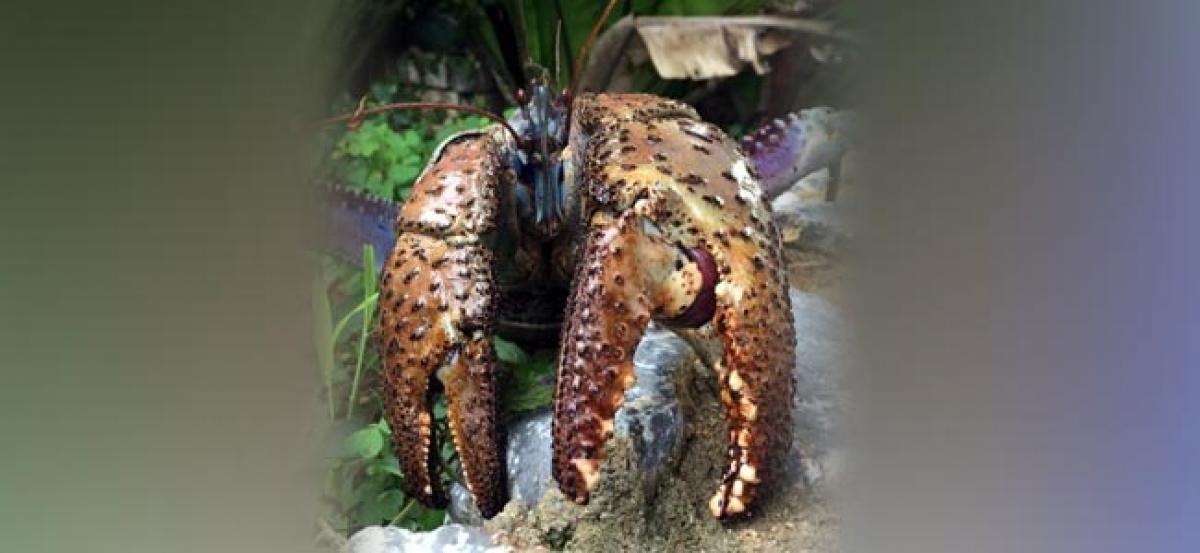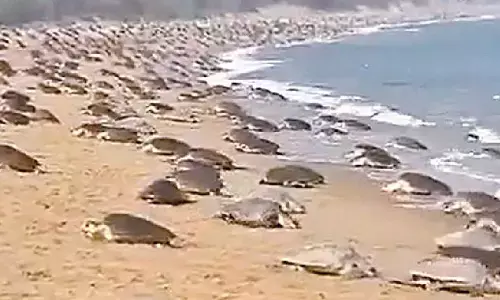Crustacean revelation - coconut crab's claw is stunningly strong

It may not be wise to get into a scrap with a coconut crab. Its claw is a mighty weapon.
WASHINGTON: It may not be wise to get into a scrap with a coconut crab. Its claw is a mighty weapon.
Scientists on Wednesday said they measured the pinch strength of this large land crab that inhabits islands in the Indian and southern Pacific oceans, calculating that its claw can exert up to an amazing 742 pounds (336.5 kg) of force.
The coconut crab's pinch strength even matches or beats the bite strength of most land predators.
"The pinching force of the largest coconut crab is almost equal to the bite force of adult lions," said marine biologist Shin-ichiro Oka of Japan's Okinawa Churashima Foundation, who led the research published in the journal PLOS ONE.
As its name indicates, this crab eats coconuts, first using its claw to scrape away the fibrous coating and then using the claw to break it open. Its menu is larger than just coconuts. The coconut crab also eats fruit, nuts, material fallen from trees, carrion and other crabs. In addition, after molting, it eats its own exoskeleton.
It is the king of crabs and other crustaceans whose pinch strength has been assessed.
"The force is remarkably strong. They can generate about 90 times their body weight," Oka added.
Oka said that if he had the equivalent pinch strength per body weight of a coconut crab he could "crush something with about 6 tons of force."
Its powerful claw is useful for self-defence as well as for accessing hard food sources that competitors may not be able to handle, Oka said.
Coconut crabs, a type of hermit crab, are the largest land crustacean and the largest terrestrial invertebrate of any kind. They can measure up to about 3 feet (1 metre) long when their 10 legs are extended and can weigh up to about 9 pounds (4 kg). They are formidable beyond merely their pinch strength, able to lift up to about 66 pounds (30 kg).
The island-dwelling species can be found as far west as Zanzibar and as far east as the Gambier Islands, with Christmas Island possessing a particularly dense population.
The researchers conducted strength tests on 29 wild coconut crabs on the Japanese island of Okinawa.
They are known as ornery creatures. As adults, they live alone in crevices or burrows and will attack other crabs that try to enter. It may not be wise to get into a scrap with a coconut crab. Its claw is a mighty weapon.
Scientists on Wednesday said they measured the pinch strength of this large land crab that inhabits islands in the Indian and southern Pacific oceans, calculating that its claw can exert up to an amazing 742 pounds (336.5 kg) of force.
The coconut crab's pinch strength even matches or beats the bite strength of most land predators.
"The pinching force of the largest coconut crab is almost equal to the bite force of adult lions," said marine biologist Shin-ichiro Oka of Japan's Okinawa Churashima Foundation, who led the research published in the journal PLOS ONE.
As its name indicates, this crab eats coconuts, first using its claw to scrape away the fibrous coating and then using the claw to break it open. Its menu is larger than just coconuts. The coconut crab also eats fruit, nuts, material fallen from trees, carrion and other crabs. In addition, after molting, it eats its own exoskeleton.
It is the king of crabs and other crustaceans whose pinch strength has been assessed.
"The force is remarkably strong. They can generate about 90 times their body weight," Oka added.
Oka said that if he had the equivalent pinch strength per body weight of a coconut crab he could "crush something with about 6 tons of force."
Its powerful claw is useful for self-defence as well as for accessing hard food sources that competitors may not be able to handle, Oka said.
Coconut crabs, a type of hermit crab, are the largest land crustacean and the largest terrestrial invertebrate of any kind. They can measure up to about 3 feet (1 metre) long when their 10 legs are extended and can weigh up to about 9 pounds (4 kg). They are formidable beyond merely their pinch strength, able to lift up to about 66 pounds (30 kg).
The island-dwelling species can be found as far west as Zanzibar and as far east as the Gambier Islands, with Christmas Island possessing a particularly dense population.
The researchers conducted strength tests on 29 wild coconut crabs on the Japanese island of Okinawa.
They are known as ornery creatures. As adults, they live alone in crevices or burrows and will attack other crabs that try to enter.






